|
Architecture
The basis of
Rusyn society throughout its entire existence has been the village.
Therefore, what can be considered original Rusyn architectural monuments
are to be found in villages. Until the twentieth century, the basic
building material among Rusyns was wood, whose versatility is no less
than that of stone.
In domestic architecture the functionally rational approach determined
style. Hence, the most important elements for houses were strong walls
and roofs, in order to protect dwellers from the severity of the
changing mountain climate, to preserve internal heat, and to guarantee
the long-term storage of provisions. Virtually until the second half of
the twentieth century the basic model for domestic dwellings throughout
most of *Carpathian Rus’ was a tripartite structure, consisting of an
entry vestibule (sini/sien’/pitvor), the living quarters (khŷzha/perednia
khŷzha), and pantry (komora). The structure was constructed from large
beech or oak logs with a four-sided sloped roof covered with straw
sheaves.
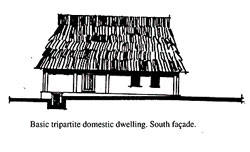 The
interior walls were covered with clay and white-washed. Along the
outside front and one side wall was a wide porch supported by carved
posts. In the living space, just to the left of the door, was an earthen
stove; under the window a large bed; to the right were benches; and in
the center a table. Small windows punctuated the front and side walls
under the porch; neither the entry vestibule or the pantry had any
windows. This was the basic model for houses, although in the *Lemko
Region, *Prešov Region, and among the *Dolyniane (lowland dwellers in *Subcarpathian
Rus’) the form of traditional houses has varied with regard to the
relative size and layout of the three parts of the structure. Also, the
roofs may have been covered with wooden shingles instead of straw,
especially in *Maramorosh county and in parts of *Spish county. From
this basic tripartite structure the so-called long house (dovha khata)
evolved with the addition of elements that resulted in a
rectangular-shaped structure. Among the elements added, usually beyond
the entry vestibule, were: the stable (stainia); threshing floor (pelevnia/boisko/stodolia),
which sometimes also housed farm machinery; a shed (shopa); and along
one side of the entire length of the structure a narrow storage area (polovnyk/pelevnyk)
for hay, straw, and grain. The
interior walls were covered with clay and white-washed. Along the
outside front and one side wall was a wide porch supported by carved
posts. In the living space, just to the left of the door, was an earthen
stove; under the window a large bed; to the right were benches; and in
the center a table. Small windows punctuated the front and side walls
under the porch; neither the entry vestibule or the pantry had any
windows. This was the basic model for houses, although in the *Lemko
Region, *Prešov Region, and among the *Dolyniane (lowland dwellers in *Subcarpathian
Rus’) the form of traditional houses has varied with regard to the
relative size and layout of the three parts of the structure. Also, the
roofs may have been covered with wooden shingles instead of straw,
especially in *Maramorosh county and in parts of *Spish county. From
this basic tripartite structure the so-called long house (dovha khata)
evolved with the addition of elements that resulted in a
rectangular-shaped structure. Among the elements added, usually beyond
the entry vestibule, were: the stable (stainia); threshing floor (pelevnia/boisko/stodolia),
which sometimes also housed farm machinery; a shed (shopa); and along
one side of the entire length of the structure a narrow storage area (polovnyk/pelevnyk)
for hay, straw, and grain.
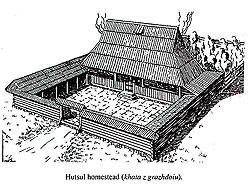 Only
in the far eastern and far western parts of Carpathian Rus’ did a
significantly different domestic architectural style evolve. Among the *Hutsuls
at the eastern edge of Subcarpathian Rus’ there existed the so-called
grazhda, or homestead with an enclosed courtyard (khata z grazhdoiu).
This was an architectural complex composed of a house and farm buildings
linked together by a high wooden wall. The result was an enclosed
architectural space, usually in the form of a square, with a single
large gate providing the only entry way into the complex. The house was
on the northern side of the complex with its windows facing into the
courtyard. The farm buildings (stable, sheep-fold, pantry) were located
along the other three walls of the courtyard. A few of the Hutsul
homesteads had a covered courtyard, of which one part near the house was
well maintained (paradnŷi podviria), while the other part was left for
work (zadviria) connected with the adjacent farm buildings. This
architectural complex reflected well the settlement pattern of the
Hutsuls and their livestock-raising economic activity, operated and
carried out by large families whose several generations often lived
within a single homestead (grazhda). Somewhat similar to the layout of
Hutsul grazhda are domestic dwellings in a few Rusyn villages (Osturňa,
Litmanová, Nižné Repaše) in far western Spish county. Only
in the far eastern and far western parts of Carpathian Rus’ did a
significantly different domestic architectural style evolve. Among the *Hutsuls
at the eastern edge of Subcarpathian Rus’ there existed the so-called
grazhda, or homestead with an enclosed courtyard (khata z grazhdoiu).
This was an architectural complex composed of a house and farm buildings
linked together by a high wooden wall. The result was an enclosed
architectural space, usually in the form of a square, with a single
large gate providing the only entry way into the complex. The house was
on the northern side of the complex with its windows facing into the
courtyard. The farm buildings (stable, sheep-fold, pantry) were located
along the other three walls of the courtyard. A few of the Hutsul
homesteads had a covered courtyard, of which one part near the house was
well maintained (paradnŷi podviria), while the other part was left for
work (zadviria) connected with the adjacent farm buildings. This
architectural complex reflected well the settlement pattern of the
Hutsuls and their livestock-raising economic activity, operated and
carried out by large families whose several generations often lived
within a single homestead (grazhda). Somewhat similar to the layout of
Hutsul grazhda are domestic dwellings in a few Rusyn villages (Osturňa,
Litmanová, Nižné Repaše) in far western Spish county.
Domestic architecture was limited in its development to the modest
utilitarian needs of the Rusyn peasant. Hence, it was in wooden church
architecture that Rusyn artistic and creative talent found an outlet.
Rusyn wooden church architecture is conventionally divided into the
Boiko and Lemko styles, from which derive the so-called Gothic style in
Maramorosh county as well as a group of Baroque-like churches. The
Hutsul churches form a separate style.
Based on their ground plans, all wooden churches can be categorized
according to two basic types: (1) the tripartite type, in which the
anteroom (babynets’), nave, and altar are in a single west-east axis;
and (2) the Greek-cross type, which is characteristic of the Hutsul
churches. The tripartite type churches are, in turn, subdivided into:
those with a single log-frame in which all three parts are encompassed
by the same set of logs; those with a double log-frame in which the
anteroom (babynets’) and nave have one set of logs and the altar another;
and those with a triple log-frame in which the anteroom, nave, and altar
each has its own set of logs. The Hutsul Greek-cross churches are
constructed of five sets of log-frames.
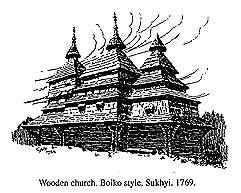 Boiko-style
churches fall into the tripartite type with a triple log-frame, in which
the central portion is higher than the other two. Each portion is
covered by low square frames upon which is a tentlike steeple that
diminishes gradually toward the top to form a pyramidlike structure. One
can observe a gradual evolution toward complexity in the form of these
steeples, from simple pyramidlike shapes to steeply sloped towers. A
dominant element is the sloping gallery-eave (galeriia-opasannia) that
encircles the entire church and protects the log-frame base of the
structure. The Boiko-type church is best preserved in the upper valleys
of the Uzh, San, Latorytsia, and Rika Rivers at villages like Uzhok,
Sukhyi, Vyshka, Kostryno, Husnyi, Verkhnii Studenyi, and beyond the
Carpathian crests in Galicia. The Boiko-style is clearly a variant of
the oldest kinds of wooden churches built many centuries ago, both in
the Carpathians and as well as in adjacent territories stretching from
Slovakia in the west to Polissia in the north, and from Podolia in the
east to the Danubian lowlands in the southwest. Under the influence of
stone construction in cities the basic architectural style throughout
the entire area gradually changed and new types of building emerged. Boiko-style
churches fall into the tripartite type with a triple log-frame, in which
the central portion is higher than the other two. Each portion is
covered by low square frames upon which is a tentlike steeple that
diminishes gradually toward the top to form a pyramidlike structure. One
can observe a gradual evolution toward complexity in the form of these
steeples, from simple pyramidlike shapes to steeply sloped towers. A
dominant element is the sloping gallery-eave (galeriia-opasannia) that
encircles the entire church and protects the log-frame base of the
structure. The Boiko-type church is best preserved in the upper valleys
of the Uzh, San, Latorytsia, and Rika Rivers at villages like Uzhok,
Sukhyi, Vyshka, Kostryno, Husnyi, Verkhnii Studenyi, and beyond the
Carpathian crests in Galicia. The Boiko-style is clearly a variant of
the oldest kinds of wooden churches built many centuries ago, both in
the Carpathians and as well as in adjacent territories stretching from
Slovakia in the west to Polissia in the north, and from Podolia in the
east to the Danubian lowlands in the southwest. Under the influence of
stone construction in cities the basic architectural style throughout
the entire area gradually changed and new types of building emerged.
Among these new types of buildings was the Lemko-style church.
Lemko-style churches are characterized by the unique and dynamic
composition of their steeples, which grow higher and higher, from a tiny
one over the altar to the several-storey central tower and, finally, to
the extremely high western bell tower in the Baroque style. Moreover,
the bell tower is not structurally related to the log-frame of the
central nave and altar, but rather is constructed on a frame of
vertical-standing logs. Lemko-style churches are most widespread in
villages along the Upper Wisłoka, Ropa, and Biała Rivers in the Lemko
Region (Poland); along tributaries of the upper Ondava and Topl’a Rivers
in the Prešov Region (Slovakia); and along the tributaries of the Upper
Latorytsia and Borzhava Rivers in Subcarpathian Rus’ (Ukraine). The
monumental beauty of these Rusyn churches has long been recognized, so
that from the 1920s to the 1960s several were removed from their
original location to enhance the beauty of parks, as in Prague/Kinský
Gardens (the church from Medvedivtsi), Košice (the church from
Kožuchovce), and Bardejovské Kúpele (the church from Mikulášová). Others
were relocated to enrich the displays in outdoor ethnographic museums/skanzens,
as in Kiev (the church from Kanora), Uzhhorod (the church from
Shelestovo), Bardejovské Kúpele (the church from Zboj), Svidník (the
church from Nová Polianka), Humenné (the church from Nová Sedlica), and
Stará L’ubovňa (the church from Matysová).
The form of Lemko-style churches gradually approached that of stucco
structures of the western type found nearby. This development occurred
spontaneously as well as under pressure from secular and church
authorities. For instance, in Lemko-style churches roofs were
constructed as single, two-sloped coverings with a small, decorative
towerlet crown over the east-end altar. The entire structure was
dominated by a bell tower in the Baroque style, as at Chornoholova,
Roztoka, Podobovets’, Pylypets’, Izky, Bukovets’, and Huklyvyi in
Subcarpathian Rus’. Such reconstructions usually date from the last
third of the eighteenth century.
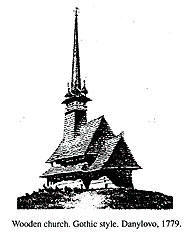 During
the late eighteenth century a new school of woodworking also evolved,
which built wooden “Gothic” churches in villages of southwestern
Maramorosh county. Stylistically they belong to a group of similar
church structures in neighboring Transylvania and northeastern Hungary.
They were modeled on the epitome of that style, the stone masonry German
Gothic church of Transylvania. In their refined form and construction,
it is clear that the center of this new school of woodworking was to be
found in the churches of Danylovo, Krainykovo, Sokyrnytsia,Steblivka/Saldobosh,
and Oleksandrivka/Shandrovo in Subcarpathian Rus’. Characteristic of
these churches is a steep sloping roof and a narrow tower and gallery
over the anteroom (babynets’) topped by a steeple at the base of which
are small decorative towers on the four corners of the gallery. The
driving spirit behind the Gothic style was its vertical thrust and the
virtual absence of walls, which were covered under the broad eaves of
the roof and gallery. All Rusyn churches in the “Gothic” style are
distinguished by a clearly defined geometrical form and an outline
according to idealized rules. During
the late eighteenth century a new school of woodworking also evolved,
which built wooden “Gothic” churches in villages of southwestern
Maramorosh county. Stylistically they belong to a group of similar
church structures in neighboring Transylvania and northeastern Hungary.
They were modeled on the epitome of that style, the stone masonry German
Gothic church of Transylvania. In their refined form and construction,
it is clear that the center of this new school of woodworking was to be
found in the churches of Danylovo, Krainykovo, Sokyrnytsia,Steblivka/Saldobosh,
and Oleksandrivka/Shandrovo in Subcarpathian Rus’. Characteristic of
these churches is a steep sloping roof and a narrow tower and gallery
over the anteroom (babynets’) topped by a steeple at the base of which
are small decorative towers on the four corners of the gallery. The
driving spirit behind the Gothic style was its vertical thrust and the
virtual absence of walls, which were covered under the broad eaves of
the roof and gallery. All Rusyn churches in the “Gothic” style are
distinguished by a clearly defined geometrical form and an outline
according to idealized rules.
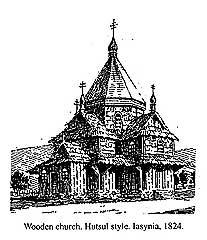 The
last group of Carpathian wooden churches are the Hutsul ones based on a
floor plan in the form of a Greek cross. In Rusyn-inhabited lands there
are only two examples, the Struk Church (1824) and the Church at
Plytovate (1780), both in the large village of Iasynia. Built over a
Greek-cross plan, the long interior space along the east-west axis is
supplemented by two side interior spaces on the south and north sides.
The side log-framed spaces are covered by sloping roofs; over the
central log-framed space sits an octagonal drum covered by a tentlike
roof crowned with a cross.The entire church appears to be a horizontal
structure subordinated to a wide-eaved roof, which as it sits on
extended corbel-supports looks like a large wreath that has fallen upon
the walls of the frame. The origins of this style of wooden churches is
unknown. From the exterior they resemble Armenian churches which, in
turn, are based on Byzantine churches. The
last group of Carpathian wooden churches are the Hutsul ones based on a
floor plan in the form of a Greek cross. In Rusyn-inhabited lands there
are only two examples, the Struk Church (1824) and the Church at
Plytovate (1780), both in the large village of Iasynia. Built over a
Greek-cross plan, the long interior space along the east-west axis is
supplemented by two side interior spaces on the south and north sides.
The side log-framed spaces are covered by sloping roofs; over the
central log-framed space sits an octagonal drum covered by a tentlike
roof crowned with a cross.The entire church appears to be a horizontal
structure subordinated to a wide-eaved roof, which as it sits on
extended corbel-supports looks like a large wreath that has fallen upon
the walls of the frame. The origins of this style of wooden churches is
unknown. From the exterior they resemble Armenian churches which, in
turn, are based on Byzantine churches.
Bibliography: Roman Reinfuss, “Budownictwo ludowe na zachodniej
Łemkowszczyźnie,” Lud, XXXIII (L’viv, 1934), pp. 83-112; Volodymyr
Sičynśkyj, Dřevěné stavby v Karpatské oblasti (Prague, 1940); Jerzy
Czajkowski, Wiejskie budownictwo mieszkalne w Beskidzie Niskim i na
przyległym Pogórzu (Rzeszów, 1969); Blanka Kovachovychova-Pushkar’ova
and Imrikh Pushkar, Dereviani tserkvy skhidnoho obriadu na Slovachchyny,
in Naukovyi zbirnyk Muzeiu ukraïns’koï kul’tury u Svydnyku, Vol. V
(Bratislava and Prešov, 1971); Vasyl’ Karmazyn-Kokovs’kyi, Mystetstvo
lemkivs’koï tserkvy (Rome, 1975); Peter I. Makushenko, Narodnaia
dereviannaia arkhitektura Zakarpat’ia XVIII-nachala XX veka (Moscow,
1976); David Buxton, The Wooden Churches of Eastern Europe (Cambridge,
1981), esp. pp. 87-147; Vasyl’ Karmazyn-Kokovs’kyi, Arkhitektura
boikivs’koï tserkvy (Philadelphia, 1982); Paul Robert Magocsi,
Holzkirchen in der Karpaten: Die Fotografien Florian Zapletals/ Wooden
Churches in the Carpathians: The Photographs of Florian Zapletal (Vienna,
1982); Myroslav Sopolyha, Narodna arkhitektura ukraïntsiv Skhidnoï
Slovachchyny (1983); Ryszard Brykowski, Łemkowska drewniana architektura
cerkiewna w Polsce, na Słowacji i Rusi Zakarpackiej (Wrocław, Warsaw,
Cracow, Gdańsk, and Łódź, 1986); Iurii H. Hoshko, ed., Narodna
arkhitektura ukraïns’kykh Karpat XV-XX st. (Kiev, 1987); Oleh Wolodymyr
Iwanusiw, Church in Ruins: The Demise of Ukrainian Churches in the
Eparchy of Peremyshl/Tserkva v ruïni: zahybel’ ukraïns’kykh tserkov
Peremys’koï Eparkhiï (St. Catharine’s, Ont., 1987); Myroslav Sopolyha,
Perly l’udovej architektúry/Perlyny narodnoï arkhitektury (Prešov,
1996); Joby Patterson, Wooden Churches of the Carpathians: A Comparative
Study (New York, 2001).
Ivan POP
|
